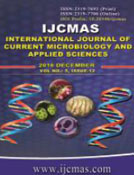


 National Academy of Agricultural Sciences (NAAS)
National Academy of Agricultural Sciences (NAAS)

|
PRINT ISSN : 2319-7692
Online ISSN : 2319-7706 Issues : 12 per year Publisher : Excellent Publishers Email : editorijcmas@gmail.com / submit@ijcmas.com Editor-in-chief: Dr.M.Prakash Index Copernicus ICV 2018: 95.39 NAAS RATING 2020: 5.38 |
This study was carried out at Eldebeibat area in El Dilling locality – South Kordofan State during the two rainy seasons of (2013 and 2014) the aim of this study was to assess the seed bank of herbaceous species and soil organic matter content. Three sites were selected namely; clay, sandy and gardud¹ site. Four transects were delineated using 100 meter tape distributed in the each site and then ten quadrats 1×1m were used to observes plants frequency% and ten soil samples 10×10cm with depth 10cm were taken along each transect to estimate relative seeds density and soil organic matter. The seeds reference were taken from standing plant species and then compared with seeds bank. Questionnaire was designed to collect primary data about the history of plant species, total of (372) respondents were selected randomly to obtain information about the invader species in the study area. The row data of seed bank were analyzed by using the floating Method, (Ramadan, 2001) and standard equations of seeds density and Excel program were used; the organic matter data were analyzed by using Furnace Method (Reddy, 2002). The results shows that the seed bank in clay site scored the lowest seeds density for both live and dead seeds, sandy site scored the highest density for both live and dead seeds) followed by gardud site. The clay site dominated by Schoenfeldia gracilis live seeds density and by Chloris gayana dead seeds density, sandy site dominated by Zornia glochidiata live seeds density and Echinochloa colona dead seeds density, while gardud site dominated by Vossia cuspidata live and dead seeds density. Soil organic matter content at the three sites scored low percentage. The study recommended to increase soil organic matter content, through planting legumes trees and shrubs and broadcasting seeds of legumes of herbaceous species in the study area and avoids early grazing at the rainy season.
 |
 |
 |
 |
 |